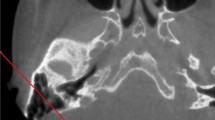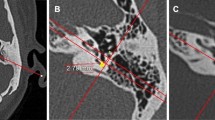Abstract
Objective
This study aimed to investigate the prevalence of tympanic plate (TP) pneumatisation as well as the various potential patterns.
Methods
A retrospective study involving the archived Cone-Beam Computed Tomography (CBCT) files of 70 patients was performed to investigate anatomical variations of TP pneumatisation.
Results
Forty-eight TPs were found to be non-pneumatised, while 92 were found to contain at least peritubal air cells. Twenty patients (28.5%) did not present any variety of TP pneumatisation, while 36 patients (51.4%) exhibited a symmetrical pattern of pneumatisation.
Conclusion
Aside from those patients who lacked TP pneumatisation, the peritubal pneumatisation pattern was found to be the most common. Further, bilateral symmetry was found to occur in more than half of all cases. CBCT is a powerful diagnostic tool, although appropriate knowledge of the anatomical possibilities remains mandatory for adequate surgical planning.








Similar content being viewed by others
References
Allam AF (1969) Pneumatization of the temporal bone. Ann Otol Rhinol Laryngol 78:49–64. https://doi.org/10.1177/000348946907800105
Altay C, Erdogan N, Batki O, Eren E, Altay S, Karasu S, Mete B, Uluc E (2014) Isolated tympanic plate fracture frequency and its relationship to mandibular trauma. Can Assoc Radiol J 65:360–365. https://doi.org/10.1016/j.carj.2014.02.004
Beaumont G (1966) The effects of exclusion of air from pneumatized bones. J Laryngol Otol 80:236–249
Bichir C, Rusu MC, Vrapciu AD, Maru N (2019) The temporomandibular joint: pneumatic temporal cells open into the articular and extradural spaces. Folia Morphol (Warsz) 78:630–636. https://doi.org/10.5603/FM.a2018.0111
Cheatle AH (1907) The infantile types of mastoid with ninety-six specimens. J Laryngol Lond 22:256
Delilbasi C, Orhan K, Icen M, Aksoy S, Horasan S, Kenan Kose S (2013) Evaluation of articular eminence pneumatization using cone beam computed tomography. Minerva Stomatol 62:349–354
Demirel O, Kaya E, Üçok CÖ (2014) Evaluation of mastoid pneumatization using cone-beam computed tomography. Oral Radiol 30:92–97
Eagleton WP (1936) A new classification of the bones forming the skull: based on their function and embryologic origin as influencing the kind, course and frequency of infections of the individual bones, with surgical applications, especially as to the relation of osseous infections to meningitis. Arch Otolaryngol 24:158–189
Gomes MB, Guimaraes SM, Filho RG, Neves AC (2007) Traumatic fractures of the tympanic plate: a literature review and case report. Cranio 25:134–137. https://doi.org/10.1179/crn.2007.020
Gray H, Standring S, Anand N, Birch R, Collins P, Crossman A, Gleeson M, Jawaheer G, Smith AL, Spratt JD, Stringer MD, Tubbs SR, Tunstall R, Wein AJ, Wigley CB (2016) Gray's anatomy: the anatomical basis of clinical practice, 41st edn. Elsevier, Amsterdam
Gupta D, Rashmi NC, Sheikh S, Pallagatti S, Goyal G, Singh R, Parnami P, Singh G (2014) The prevalence, radiographic appearance, and characteristics of zygomatic air cell defects (ZACDs) in symptomatic temporomandibular joint disorder patients in North Indian population. Oral Maxillofac Surg 18:453–457. https://doi.org/10.1007/s10006-013-0438-x
Han SJ, Song MH, Kim J, Lee WS, Lee HK (2007) Classification of temporal bone pneumatization based on sigmoid sinus using computed tomography. Clin Radiol 62:1110–1118. https://doi.org/10.1016/j.crad.2007.04.019
Hasnaini M, Ng SY (2000) Extensive temporal bone pneumatization: incidental finding in a patient with TMJ dysfunction. Dent Update 27:187–189. https://doi.org/10.12968/denu.2000.27.4.187
Hayashi T, Ito J, Koyama J-i (1998) Gas in the temporomandibular joint: computed tomography findings: report of 3 cases. Oral Surg Oral Med Oral Pathol Oral Radiol Endodontol 86:751–754
Jackler RK, Schindler RA (1984) Role of the mastoid in tympanic membrane reconstruction. Laryngoscope 94:495–500
Jadhav AB, Fellows D, Hand AR, Tadinada A, Lurie AG (2014) Classification and volumetric analysis of temporal bone pneumatization using cone beam computed tomography. Oral Surg Oral Med Oral Pathol Oral Radiol 117:376–384. https://doi.org/10.1016/j.oooo.2013.12.398
Lacout A, Marsot-Dupuch K, Smoker WR, Lasjaunias P (2005) Foramen tympanicum, or foramen of Huschke: pathologic cases and anatomic CT study. AJNR Am J Neuroradiol 26:1317–1323
McKenzie D (1920) The aqueduct of Fallopius and facial paralysis. J Laryngol Otol 35:201–210
Miloglu O, Yalcin E, Buyukkurt M, Yilmaz A, Harorli A (2010) The frequency of bifid mandibular condyle in a Turkish patient population. Dentomaxillofac Radiol 39:42–46. https://doi.org/10.1259/dmfr/38196548
Montalbetti L, Ferrandi D, Pergami P, Savoldi F (1995) Elongated styloid process and Eagle's syndrome. Cephalalgia 15:80–93. https://doi.org/10.1046/j.1468-2982.1995.015002080.x
Ojala L (1950) Contribution to the physiology and pathology of mastoid air cell formation; histological studies of aged individuals and newborn infants. Acta Otolaryngol Suppl 86:1
Ojala L (1957) Pneumatization of the bone and environmental factors; experimental studies on chick humerus. Acta Otolaryngol Suppl 133:3
Orhan K, Delilbasi C, Orhan AI (2006) Radiographic evaluation of pneumatized articular eminence in a group of Turkish children. Dentomaxillofac Radiol 35:365–370. https://doi.org/10.1259/dmfr/77401728
Palva T, Palva A (1966) Size of the human mastoid air cell system. Acta Otolaryngol 62:237–251
Proetz AW (1922) LXVIII. Observations upon the formation and function of the accessory nasal sinuses and the mastoid cells. Ann Otol Rhinol Laryngol 31:1083–1099
Shambaugh GE, Glasscock ME (1980) Surgery of the ear. WB Saunders, Philadelphia
Shamshad MP, Kamath G, Babshet M, Srikanth HS, Doddamani L (2018) Prevalence of temporal bone pneumatization in relation to temporomandibular joint—a computed tomographic study. J Stomatol Oral Maxillofac Surg 119:118–121. https://doi.org/10.1016/j.jormas.2017.11.016
Stoopler ET, Pinto A, Stanton DC, Mupparapu M, Sollecito TP (2003) Extensive pneumatization of the temporal bone and articular eminence: an incidental finding in a patient with facial pain. Case report and review of literature. Quintessence Int 34:211–214
Tumarkin A (1957) On the nature and vicissitudes of the accessory air spaces of the middle ear. J Laryngol Otol 71:211–248
Virapongse C, Sarwar M, Bhimani S, Sasaki C, Shapiro R (1985) Computed tomography of temporal bone pneumatization: 1. Normal pattern and morphology. AJR Am J Roentgenol 145:473–481. https://doi.org/10.2214/ajr.145.3.473
Wittmaack K (1918) Über die normale und die pathologische Pneumatisation des Schläfenbeines: einschliesslich ihrer Beziehungen zu den Mittelohrerkrankungen. Gustav Fischer Verlag, Jena
Wood CP, Hunt CH, Bergen DC, Carlson ML, Diehn FE, Schwartz KM, McKenzie GA, Morreale RF, Lane JI (2014) Tympanic plate fractures in temporal bone trauma: prevalence and associated injuries. AJNR Am J Neuroradiol 35:186–190. https://doi.org/10.3174/ajnr.A3609
Acknowledgements
All authors have equally contributed to this study.
Funding
This study received no funding.
Author information
Authors and Affiliations
Corresponding author
Ethics declarations
Conflict of interest
None.
Additional information
Publisher's Note
Springer Nature remains neutral with regard to jurisdictional claims in published maps and institutional affiliations.
Rights and permissions
About this article
Cite this article
Rusu, M.C., Săndulescu, M. & Bichir, C. Patterns of pneumatization of the tympanic plate. Surg Radiol Anat 42, 347–353 (2020). https://doi.org/10.1007/s00276-019-02415-4
Received:
Accepted:
Published:
Issue Date:
DOI: https://doi.org/10.1007/s00276-019-02415-4




